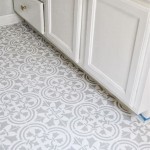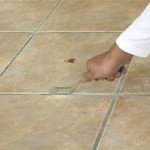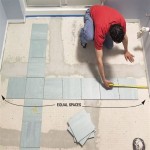Laying Tile on Cement Floor: A Comprehensive Guide
Cement floors present a durable and often cost-effective subfloor option for various types of tile. Installing tile directly onto a cement floor can create a beautiful and long-lasting surface. However, proper preparation and execution are crucial to ensure the longevity and integrity of the tiled surface. This article delves into the necessary steps and considerations involved in successfully laying tile on a cement floor.
Preparation is Paramount
The success of any tiling project hinges significantly on the preparation of the substrate. A well-prepared cement floor provides a stable and level foundation, minimizing the risk of tile cracking, shifting, or debonding. This preparation involves several key steps, each designed to address specific issues that could compromise the final result.
The first step is a thorough cleaning. The cement floor must be completely free of debris, dirt, dust, grease, paint, sealers, and any other contaminants. These materials can interfere with the adhesion of the mortar, leading to tile failure. Sweeping and vacuuming are essential first steps. Following this, a scrub brush and a suitable cleaning solution should be used to remove any remaining residue. For stubborn stains or grease, a degreasing agent may be necessary. The floor should be rinsed thoroughly with clean water and allowed to dry completely before proceeding.
Next, the levelness of the cement floor needs to be assessed. Using a long level (at least 6 feet), identify any high or low spots. Unevenness in the subfloor can cause tiles to crack or become unevenly set. Minor imperfections (less than 1/4 inch over a 10-foot span) can often be addressed with the mortar bed. However, larger variations require more significant remediation. Self-leveling compounds can be used to fill low spots and create a perfectly level surface. For high spots, grinding may be necessary to achieve a smooth and even plane. It is essential to follow the manufacturer's instructions for the self-leveling compound, paying close attention to mixing ratios and curing times.
Finally, inspect the cement floor for cracks. Cracks, even hairline cracks, can telegraph through the tile and cause them to crack as well. Small, non-structural cracks can often be addressed with a crack isolation membrane. These membranes are designed to absorb minor movement in the subfloor and prevent it from transferring to the tile. Larger, structural cracks, however, may indicate a more serious problem with the foundation and should be addressed by a qualified professional before proceeding with the tiling project. Ignoring structural cracks can lead to significant tile damage and potentially compromise the integrity of the entire floor.
Selecting the Right Materials
Choosing the correct materials is vital for a successful and durable tile installation on a cement floor. The selection process involves considering several factors, including the type of tile, the type of mortar, and the need for waterproofing or crack isolation.
Tile selection depends on various factors such as aesthetics, durability, and intended use. Ceramic tile is a popular choice for its versatility and affordability. Porcelain tile is denser and more durable, making it suitable for high-traffic areas. Natural stone tile, such as granite or marble, offers a luxurious look but requires more maintenance. The thickness of the tile also matters; thicker tiles are generally more durable and less prone to cracking. When selecting tile, it's crucial to consider the floor's intended use. For example, a bathroom floor requires tile that is slip-resistant and water-resistant.
Mortar selection is equally critical. Thin-set mortar is the most common type used for tile installation. There are different types of thin-set mortar, each formulated for specific types of tiles and substrates. Modified thin-set mortar contains polymers that enhance its adhesion and flexibility, making it a good choice for cement floors that may experience slight movement. Unmodified thin-set mortar is typically used for setting moisture-sensitive tiles like natural stone. Always consult the tile manufacturer's recommendations for the appropriate type of mortar. Also, consider the specific environment. For areas exposed to moisture, a waterproof mortar should be used.
Depending on the location and condition of the cement floor, a crack isolation membrane or waterproofing membrane may be necessary. As mentioned earlier, crack isolation membranes help prevent cracks in the subfloor from telegraphing through the tile. Waterproofing membranes are essential for areas exposed to moisture, such as bathrooms and kitchens. These membranes create a watertight barrier that protects the subfloor from water damage. There are various types of membranes available, including liquid-applied membranes and sheet membranes. Liquid membranes are applied with a roller or brush, while sheet membranes are unrolled and adhered to the subfloor. It's important to follow the manufacturer's instructions for proper application and curing of these membranes.
The Installation Process
The actual tile installation process requires careful attention to detail and adherence to best practices. From laying out the tiles to grouting the joints, each step contributes to the overall aesthetic and longevity of the tiled surface.
Before applying any mortar, dry-lay the tiles to determine the best layout. This involves placing the tiles on the floor without any adhesive to visualize the final pattern and identify any potential issues, such as awkward cuts or uneven spacing. Start by finding the center of the room and marking it. Then, using a chalk line, snap lines perpendicular to each other that intersect at the center point. These lines will serve as guides for laying the first row of tiles. Adjust the layout as needed to minimize cuts and ensure a balanced appearance. Consider the placement of full tiles and partial tiles, paying attention to how they will align with walls and doorways. Once satisfied with the layout, mark the position of each tile with a pencil or tape.
Mix the thin-set mortar according to the manufacturer's instructions. Proper consistency is crucial for achieving adequate adhesion. The mortar should be thick enough to hold its shape but still be workable. Avoid adding too much water, as this can weaken the mortar. Apply the mortar to the cement floor using a notched trowel. The size of the notches on the trowel depends on the size and type of tile being installed. Hold the trowel at a 45-degree angle and apply even pressure to create consistent ridges in the mortar. Work in small sections, applying only enough mortar to set a few tiles at a time to prevent the mortar from drying out. Set the tiles onto the mortar, pressing firmly and twisting slightly to ensure good contact. Use tile spacers to maintain consistent grout lines. Check the tiles for levelness using a level and adjust as needed. Remove any excess mortar from the tile surfaces with a damp sponge.
Allow the mortar to cure completely according to the manufacturer's recommendations, typically 24 to 48 hours. Once the mortar has cured, remove the tile spacers and prepare to grout the joints. Select a grout color that complements the tile and mix the grout according to the manufacturer's instructions. Apply the grout to the tile joints using a grout float, pressing firmly to fill the joints completely. Remove excess grout from the tile surfaces with a damp sponge, rinsing the sponge frequently. After the grout has partially dried, use a grout sponge to smooth and shape the grout lines. Allow the grout to cure completely, typically 72 hours, before sealing the grout lines. Sealing the grout helps protect it from stains and moisture damage. Apply a grout sealer according to the manufacturer's instructions. Clean the tile surface with a tile cleaner to remove any remaining grout haze.
:max_bytes(150000):strip_icc()/can-you-install-tile-directly-on-concrete-1822600-04-458f7bb6c78348c1835cf8054ef36553.jpg?strip=all)
How To Install Tile Over Concrete
How To Tile Onto Concrete Floors Porcelain Super

Tiling Over A Ed Concrete Slab Fine Homebuilding
How To Lay Floor Tiles On Concrete Stonesuper

How To Lay Floor Tiles On Concrete Welcome The Rubi Tools Blog
When Cementing Tile Why Do People Add Rows To The Cement Instead Of Just Leaving It Smooth Quora

Can You Lay Tiles Onto Damp Concrete Atlas Ceramics

How To Install Ceramic Tiles On Concrete Floor Tile Installation

Materials Needed To Lay Tile Floor The Best Tools Rubi Blog Usa
:max_bytes(150000):strip_icc()/can-you-install-tile-directly-on-concrete-1822600-01-8a89ceab1a274fb8ac81890ab7fc6b1b.jpg?strip=all)
How To Install Tile Over Concrete
Related Posts








